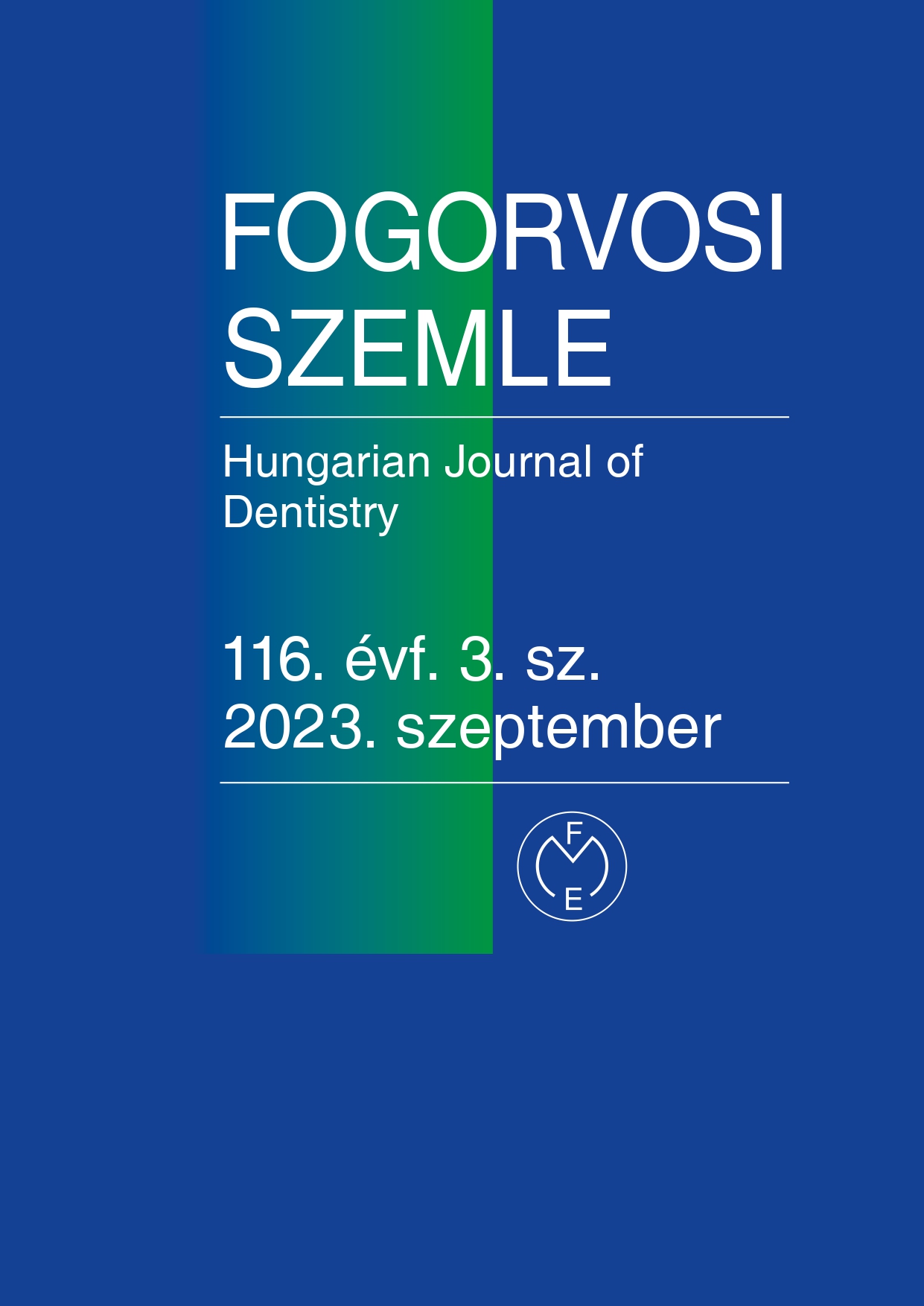Dental fear and anxiety, dental rehabilitation of an anxious patient, long-term follow-up
Abstract
Introduction: Anxiety related to dental treatments is a phenomenon known to all dentists. Recognizing and alleviating
this emotional response is the dentists’ duty. When dental fear progresses into phobia, and the patient reacts to every
dental procedures related situation with such intense fear that it already affects her entire behavior and general condition,
external help may be necessary.
Material and methods: Dental fear and anxiety. It is important to be able to separate a panic attack from other lifethreatening
conditions (e.g. heart attack, anaphylactic shock). The symptoms of a panic attack are quite common and
can be extremely sever, such as shortness of breath, feeling of suffocation, tachycardia, chest pain, trembling of the
limbs, feeling of fainting, fear of death.
Measurement of dental anxiety: Several questionnaires are available to measure dental fear, the two most significant
of which (Dental Anxiety Scale and Dental Fear Survey) are also available in Hungarian.
Treatment of dental fear: The most important and fundamental method is a detailed communication with the patient.
The “tell-show-do” technique: we describe in simple words what will happen during the treatment, then we show the patient
what tools we are going to use.
Results, Case report: In our case report, we present the oral rehabilitation of a patient with severe dental fear. During
the treatment of the lady, her dental fear could be significantly reduced, her willingness to cooperate steadily improved,
and consequently a demanding dental prosthesis, including an implant prosthetic solution could be made.
Discussion: Recognition of dental anxiety from the initial steps and the use of anxiety-relieving methods (that can be
easily applied “chair side”) facilitating a significant improvement in the quality of life of a young lady. The long-term follow-
up confirm that the patient’s oral health related quality of life significantly improved.
References
Allen, KD (2006): Management of Children's Disruptive Behavior During Dental Treatment. In D. I. Mostofsky, A. G. Forgione, & D. B. Giddon (Eds.), Behavioral dentistry (pp. 175–187). Blackwell Publishing. http://doi.org/10.1007/978-0-387-09817-3_27
Balogh, Georgina (2019): „Fogászati félelem és szorongás vizsgálata egyetemisták körében”. Acta Sana 12 (2. suppl.):8-12. https://ojs.bibl.u-szeged.hu/index.php/actasana/article/view/32026.
Beck Anita (2017): A fogászati félelem diagnosztikájának lehetőségei, különös tekintettel a szabadkézi rajzból, a kézírásból és a nyálszekrétumból mérhető paraméterekre, Doktori értekezés, Semmelweis Egyetem Klinikai Orvostudományok Doktori Iskola DOI:10.14753/SE.2016.1941 http://dx.doi.org/10.14753/SE.2016.1941
Corah NL: Development of a dental anxiety scale. J Dent Res. 1969 Jul-Aug;48(4):596. doi: 10.1177/00220345690480041801. PMID: 5256508. https://doi.org/10.1177/00220345690480041801
Corah NL, Gale EN, Illig SJ: Assessment of a dental anxiety scale. J Am Dent Assoc. 1978 Nov;97(5):816-9. doi: 10.14219/jada.archive.1978.0394. PMID: 31377. https://doi.org/10.14219/jada.archive.1978.0394
Déri, T (2022): Lenyomatvételi eljárások. In Hermann, P., Kispélyi, B., (szerk): Fogpótlástan. (pp. 835-838). Semmelweis Kiadó
Fábián TK, Handa T, Szabó M, Kelemen P, Kaan B, Fábian G: A "Dental Fear Survey" (a "Fogászati félelem kérdőív") magyar fordítása, hazai populáción végzett mérések eredményei [The Hungarian translation of the "Dental Fear Survey" based on the Hungarian population]. Fogorvosi Szemle 1999 Oct;92(10):307-15. Hungarian. PMID: 10575818.
Fábián TK, Kelemen P, Fábián G: A Dental Anxiety Scale ("Fogászati szorongásskála") hazai bevezetése. Magyar populáción végzett fogászati szorongás-epidemiológia vizsgálatok [Introduction of the concept of Dental Anxiety Scale in Hungary. Epidemiologic studies on the Hungarian population]. Fogorvosi Szemle 1998 Feb;91(2):43-52. Hungarian. PMID: 9497611.
Hällström T, Halling A: Prevalence of dentistry phobia and its relation to missing teeth, alveolar bone loss and dental care habits in an urban community sample. Acta Psychiatr Scand. 1984 Nov;70(5):438-46. doi: 10.1111/j.1600-0447.1984.tb01232.x. PMID: 6334975. https://doi.org/10.1111/j.1600-0447.1984.tb01232.x
Milgrom P, Kleinknecht RA, Elliott J, Liu HH, Teo CS: A cross-cultural cross validation of the Dental Fear Survey in South East Asia. Behav Res Ther. 1990;28(3):227-33. doi: 10.1016/0005-7967(90)90005-4. PMID: 2369405. https://doi.org/10.1016/0005-7967(90)90005-4
Neverlien PO: Assessment of a single-item dental anxiety question. Acta Odontol Scand. 1990 Dec;48(6):365-9. doi: 10.3109/00016359009029067. PMID: 2288208. https://doi.org/10.3109/00016359009029067
Szentpétery, A (2008): Fogászati artikulátorok, Arcíves átvitel, Az artikulátor beállítása egyéni értékekre In Hermann, P., Szentpétery, A., (szerk): Gnatológia. (pp. 235-245) Semmelweis Kiadó
Vértes, G, Fábián, TK (2007): Fogorvosi pszichoszomatika. Medicina Kiadó
Copyright (c) 2023 Authors

This work is licensed under a Creative Commons Attribution 4.0 International License.


.png)




1.png)



